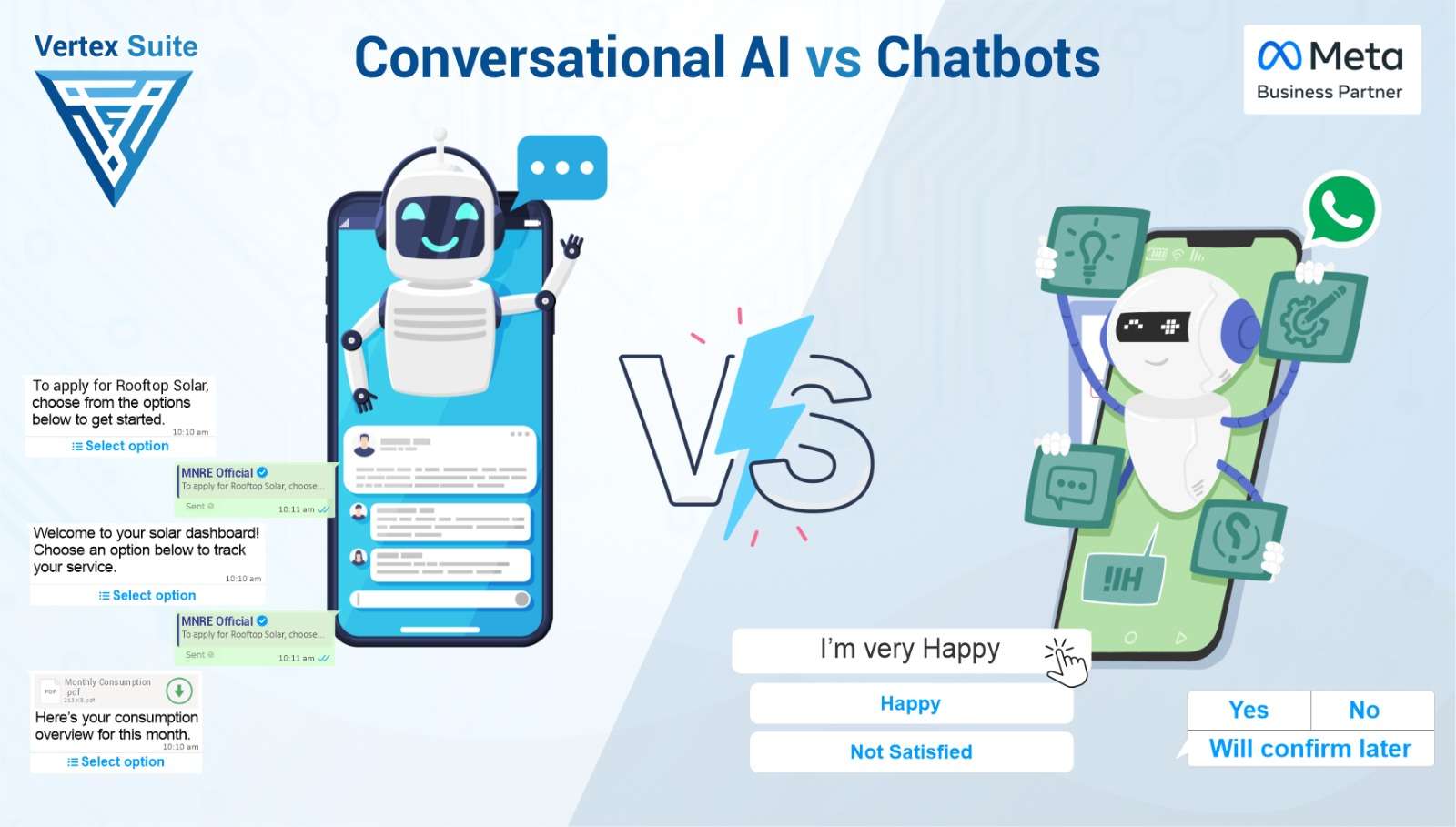Automation has become the foundation of almost every industry in the evolving digital realm. Automation usage is growing rapidly at various level be it customer service, marketing, healthcare or retail to improve user experiences, boost productivity and drive efficiency. Among the various automation technologies, chatbots and conversational AI are particularly revolutionary. These technologies are radically changing how people can communicate, how organizations can run and how industries can serve their customers efficiently. What once looked futuristic is now an essential component of our everyday lives and business operations.
Let’s examine how chatbot and conversation AI functions and distinctions between both to understand it better. We'll also check on how companies are adopting these technologies to automate procedures, the benefits they can offer and the potential for a hybrid strategy to increase productivity and client satisfaction even further.
Chatbots: The Basics of Automation
One of the most often used automated communication tools is chatbots. By giving predetermined responses based on the inputs they receive, they are meant to imitate user conversations. Without requiring human assistance, these systems assist users with completing activities or retrieving information by using rules or preprogrammed replies.
How chatbots operate
Ideally chatbots operate according to a set of preprogrammed rules. The majority of chatbots function in one of the ways listed below:
Rule-Based Chatbots: To answer user questions, the chatbots use a series of pre-programmed commands. They are most effective at simple, repetitive jobs like assisting consumers with website navigation or responding to frequently asked questions. For instance, an e-commerce website's rule-based chatbot might inquire, "Do you need help with placing an order?" and then provide consumers pre-written answers to help them.
Keyword Recognition: To get particular answers, certain chatbots employ keywords or key phrases. This is still constrained by the range of terms it can identify, but it offers greater versatility than a basic rule-based chatbot.
Menu/Button-Based Chatbots: These chatbots offer choices in the shape of menus or buttons. The engagement is more structured because users can choose how to continue the chat.
Features of Chatbots
Task Automation: Chatbots can manage basic routine tasks like retrieving account information, order processing, order tracking, suggest products, help in registeration and responding to frequently asked questions.
Instant Response: Without requiring human intervention, they offer 24/7 instant support.
Scalability: Chatbots are very scalable since they can manage several requests at once.
Ease of Integration: Integrating them with websites, apps and social media platforms is simple, enabling companies to interact with clients for basic questions.
Cost-Effective: Small and medium-sized organizations find chatbots to be an appealing solution because they are comparatively cheap to deploy.
Conversational AI: Elevating Interaction with Intelligence
Chatbots have restrictions due to their rule-based nature, whereas conversational AI is a more advanced kind of automation. Natural language processing (NLP), machine learning (ML), and deep learning are all combined in conversational AI to create more realistic, human-like interactions. Conversational AI is able to comprehend, interpret, and react to user inquiries more dynamically than chatbots, which are based on predefined scripts.
How Conversational AI Works
Natural Language Processing (NLP):-
Conversational AI uses natural language processing (NLP) which helps the system in comprehending and processing user language and texts in the form of natural language. NLP enables the AI to understand the user's question by breaking language into constituents such as syntax, semantics and intent.
Contextual Understanding: -
Conversational AI has the capability to analyse the chat or purchase history unlike chatbot which works on predefined context. The conversation with AI tends to be more organic and pertinent as it has the ability to recall past conversations and react appropriately.
Machine Learning (ML):-
Conversational AI is made possible by machine learning (ML), which allows it to continuously learn and get better via interactions. The AI gets more proficient at interpreting language and anticipating user desires with each new exchange.
AI-Driven Reactions:-
Conversational AI is capable of generating relevant and user-specific replies based on its understanding. This can include dynamic content that changes as the conversation progresses, such as suggestions, customized offers, or help.
Features of Conversational AI
Contextual Understanding:
By understanding the context of a conversation, conversational AI can improve the flow and reduce the robot kind of interactions.
Personalization:
By customizing responses according to user information and choices, it can offer a more personalised experience.
Self-Learning:
Over time, conversational AI systems get smarter and more effective by learning from each interaction.
Human-Like Conversations:
AI can have more meaningful, organic conversations with users by imitating human speech patterns.
Omnichannel Presence:
Conversational AI can function on a variety of platforms, such as social media, voice assistants (like Google Assistant and Alexa), websites and applications.
Differences Between Chatbots and Conversational AI
Conversational AI and chatbots have similar functions, however they differ greatly in terms of functionality, adaptability, and capabilities:
1. Complexity:
Chatbots: Usually made for simple, recurring activities. They are unable to handle complex or ambiguous questions and adhere to a predefined flow.
Conversational AI: Manages increasingly complex conversations. It can generate intelligent responses, even for complex talks, and is aware of context and linguistic variations.
2. Capacity for Learning:
Chatbots: Rule-based, which means they don't pick up knowledge from conversations. They only react in accordance with pre-written scripts.
Conversational AI: Improves its responses over time by learning and developing through machine learning.
3. Natural Communication:
Chatbots are unable to have dynamic conversations and are only able to respond to precise orders.
Conversational AI: Adapts to the conversation's flow and has contextual awareness to have human-like discussions.
How Businesses and Industries Are Using These Technologies
Chatbot
Customer Care: - Chatbot are used by many companies to automate customer care. Chatbot assist human agents by reducing their workload and providing prompt answers to common questions and basic client requests.
E-commerce: - Chatbot help with online shopping by tracking orders, making product recommendations, and helping with payments.
Healthcare: - Symptom checks, appointment scheduling, and health advice are all handled by simple chatbots.
Conversational AI
Banking: Banks are utilizing conversational AI to transform customer service. Banks are using AI-driven interactions to help clients comprehend complex financial products, help with loan applications, and provide individualized financial advice.
Retail: To enhance overall customer engagement, provide custom product recommendations, and help with shopping experiences, retailers are utilizing conversational AI.
Hybrid Model: Integrating Conversational AI with Chatbots
Many companies are choosing a hybrid strategy that blends the intelligence of conversational AI with the ease of use of chatbots as they look to automate more tasks. With this method, conversational AI handles more complex conversations, while chatbots manage basic questions and FAQs.
How It Operates:
The chatbot handles basic tasks like scheduling appointments and checking the status of orders. Conversational AI steps in as a conversation gets more complicated or have to answer calls. It seems like user talking to a person in real.
Why Companies Are Making Use of It:
Businesses can strike a balance between productivity and personalized customer service with this hybrid strategy. It guarantees that clients receive excellent, context-aware support when needed while saving time and money.
Voice Assistants and Conversational Commerce:
By enabling users to shop and carry out things they want using voice commands, the combination of conversational AI with voice assistants (such as Alexa, Siri and Google Assistant) will increase the expansion of conversational commerce.
Conclusion:
Chatbots and conversational AI are transforming the way businesses can automate their processes and engage with customers. While chatbots offer simplicity and efficiency, conversational AI brings intelligence and depth to interactions. Automation has a bright future, and as these technologies develop, there will be countless opportunities for efficiency, customisation, and customer interaction.
Early adopters of this change will be in a strong position to maintain their competitive edge by providing their clients with smooth, intelligent and highly customized experiences.


